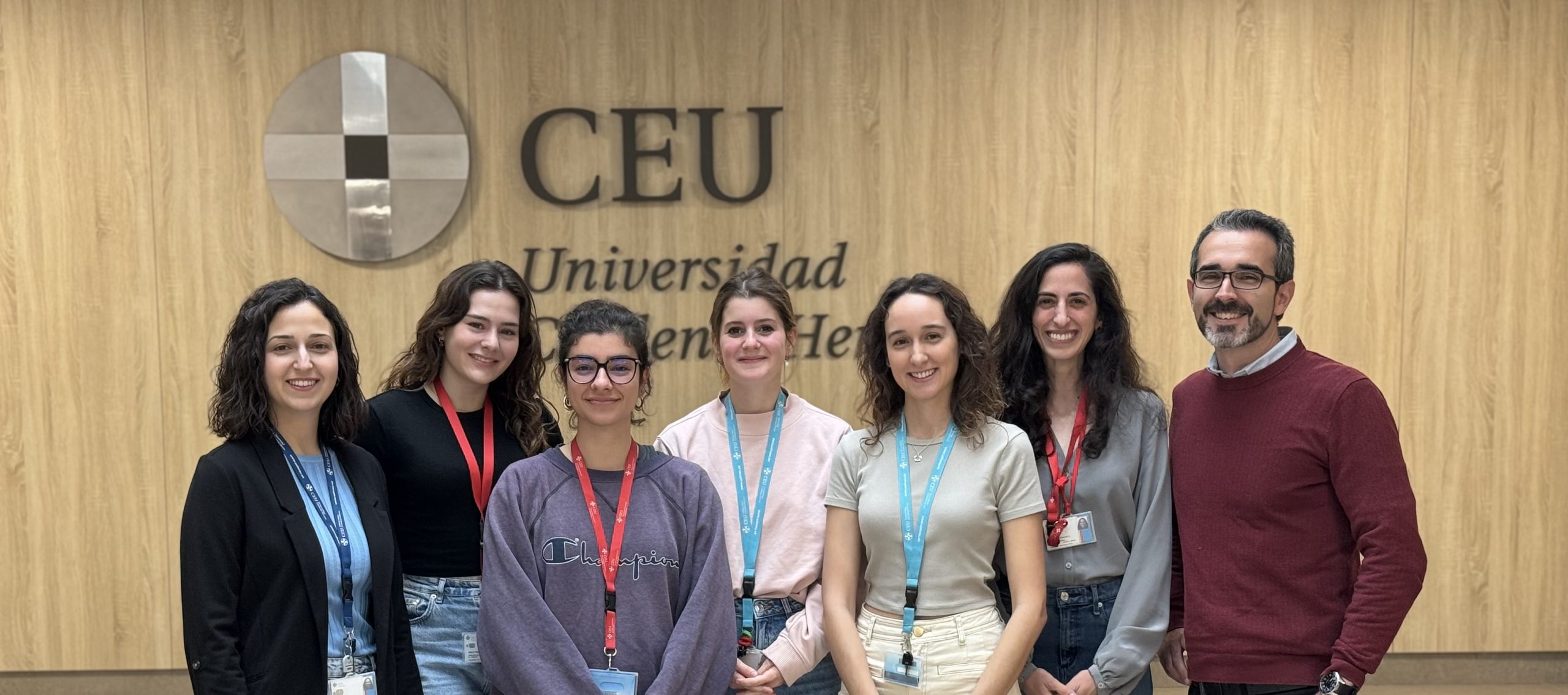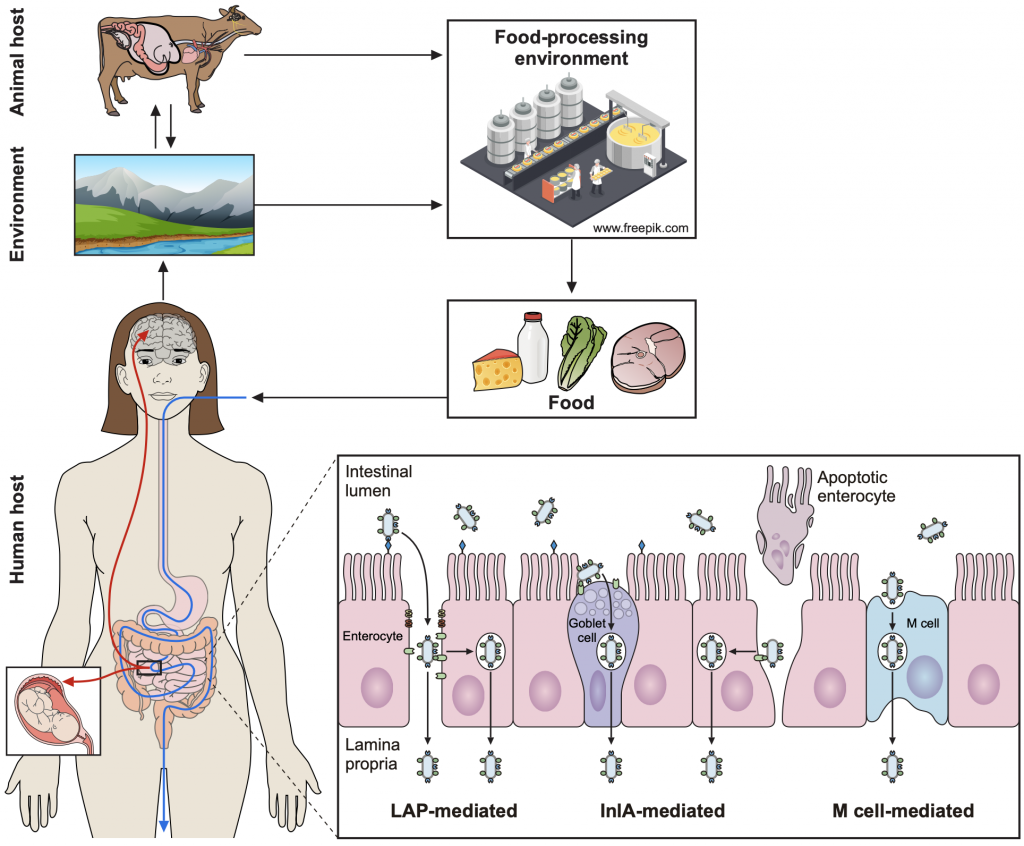 Group photo. From left to right: Inmaculada López Almela, Mireia Palanca Gisbert, Alba Espí Malillos, Juliette Poujol de Molliens, Carla Palacios Gorba, Yuval Markovich, Juan José Quereda Torres.
Group photo. From left to right: Inmaculada López Almela, Mireia Palanca Gisbert, Alba Espí Malillos, Juliette Poujol de Molliens, Carla Palacios Gorba, Yuval Markovich, Juan José Quereda Torres.
Listeriosis: current situation
Listeriosis is the most serious foodborne zoonosis with the highest hospitalization and fatality rate. Listeriosis is caused by L. monocytogenes, a bacterial pathogen distributed globally in a wide variety of domestic and wild mammalian and non-mammal species. L. monocytogenes is a facultative, osmo- and halotolerant intracellular Gram-positive bacterium that grows in a wide range of temperatures (between 1 °C and 45 °C) and pH (5-9) (Quereda et al., 2021 Virulence). Although different countries have adopted rigorous food safety standards, major listeriosis outbreaks continue to occur around the world (for example: South Africa in 2017 with 1,060 affected, Spain in 2019 with 222 affected). In a study that evaluated the epidemiological situation of listeriosis in Spain according to the hospitalization registry (Herrador et al., 2019), between 1997 and 2015 there were 5,696 hospitalizations due to listeriosis. It is important to highlight that the incidence of the disease in Spain was increasing throughout the study period, especially in those over 65 years of age. These prevalence results highlight the need to understand the circulation routes and reservoirs of this bacteria. In both humans and animals, infection by L. monocytogenes It is mainly attributed to the consumption of contaminated foods.

ScEYEnce Studios. Garland Science. KVIR-2020-0377. Figure: Graphical Abstract
Gender Listeria
The gender Listeria currently includes 27 recognized species of small, rod-shaped, gram-positive bacteria ubiquitous in nature. One of the last species was discovered by our group and was named Listeria valentina in reference to Valencia, the region where the bacteria was found (Quereda et al., 2020 Int J Syst Evol Microbiol). L. monocytogenes It is found in soil, water, vegetation, mud and silage, as well as in a wide range of animal species. It has also been detected L. monocytogenes in the feces of healthy people, with a prevalence of fecal carriers of L. monocytogenes in the general population of 10%. Ruminants and wild animals can be carriers of L. monocytogenes and frequently excrete this pathogen in feces, disseminating it on the farm and in the environment.
Today, regulatory authorities consider that all strains isolated from L. monocytogenes They are just as virulent. However, the population of L. monocytogenes It is diverse. Lineage I is isolated more frequently in samples from clinically affected patients, while lineage II strains are more common in foods. Traditionally, most pathogenesis studies of L. monocytogenes have been performed with lineage II reference strains isolated on very rare occasions from patients with clinical signs. The continued use of these reference strains has led to an underestimation of the biodiversity of L. monocytogenes and, therefore, the heterogeneity that may exist in the virulence mechanisms used by lineage I and II strains.
Group history
Our group started in 2018 after receiving a Ramón y Cajal contract, followed by projects from the Ministry (PID2019 and PID2022) and the Generalitat Valenciana for Emerging Groups and later for Consolidated Groups (GV/2018//183 and AICO 2021). Applying molecular epidemiology techniques and whole genome sequencing, our group has discovered one of the last species of the genus Listeria, L. valentina (Quereda et al., 2020 Int J Syst Evol Microbiol) and has shown how the clonal complex of L. monocytogenes most prevalent associated with human listeriosis (CC1) is precisely strongly associated with ruminants (Palacios-Gorba et al., 2021 Environ Microbiol). Our group has studied the role of different bacterial and eukaryotic cell factors that mediate during infection (Quereda et al., 2018 Vet Res; 2019 Clin Microbiol Infect; 2022 J Infect Dis). Likewise, we have also discovered the asymptomatic carrier state of L. monocytogenes in domestic and wild animals, identifying the tonsils as a reservoir organ for this pathogen (Palacios-Gorba et al., 2021 Applied and Environ Microbiol; 2023 Microbes and Infection). Our group has described the existence of atypical infections of Listeria in cases of mesenteric lymphadenitis in companion animals, revealing the genomic diversity of the strains in the lesions and evidencing the importance of companion animals in the biological cycle of L. monocytogenes (Garcia-de la Virgen & López-Almela et al., 2024 J Vet Intern Med). Finally, by carrying out growth kinetics and proteomics studies, we have been able to reveal why hypervirulent clones of L. monocytogenes They are mainly associated with dairy products, while we have been able to understand how this pathogen readapts its membrane and wall proteome to the conditions of products derived from the host such as milk (Espí-Malillos et al., 2024 Microbes and Infection).
The group applies genomic approaches from the One-Health perspective to better understand the behavior, transmission, virulence and evolution of the genus Listeria and its association with human and animal hosts. We develop multidisciplinary projects based on various disciplines including animal health, epidemiology, genomics, microbiology and molecular biology. Understand the reservoirs, epidemiology, molecular mechanisms of pathogenesis and the genetic and phenotypic diversity of L. monocytogenes will help understand how this bacteria changes its lifestyle from saprophytic to pathogenic, improving human and animal health, reducing the transmission of pathogens and contamination of food products of animal origin to ultimately increase food safety.
Representative Publications
Espí-Malillos A, Palacios-Gorba C, López-Almela I, Ruiz-García P, López-Mendoza MC, García-Del Portillo F, Pucciarelli MG, Quereda JJ. Kinetic and proteomic studies in milk show distinct patterns among major Listeria monocytogenes clones. Microbes Infect. 2024
Garcia-de la Virgen M, López-Almela I, Moura A, Vázquez S, Perez-Montagud S, Leclercq A, Lecuit M, Quereda JJ. Clinical and genomic features of Listeria monocytogenes-associated mesenteric lymphadenitis in a cat. J Vet Intern Med. 2024
Barba M, Toquet M, García-Roselló E, Gomis J, Quereda JJ, González-Torres P, Carbonetto B, Gómez-Martín Á. Description of the vaginal microbiota in nulliparous ewes during natural mating and pregnancy: preliminary signs of the male preputial microbiota modulation. Front Microbiol. 2024
Toledo-Perona R, Contreras A, Gomis J, Quereda JJ, García-Galán A, Sánchez A, Gómez-Martín A. Controlling Coxiella burnetii in naturally infected sheep, goats and cows, and public health implications: a scoping review. Front. Vet. Sci. 2024.
Palacios-Gorba C, Moura A, Markovich Y, Tessaud-Rita N, Gómez-Martín Á, Bracq-Dieye H, Gomis J, Vales G, Pastor-Martín M, Thouvenot P, Escrig C, Leclercq A, Lecuit M, Quereda J.J. Genomic characterization of Listeria spp. isolated from tonsils, udder and feces of domestic dairy ruminants in Spain. Microbes Infect. 2023
Quereda JJ, Morel C, Lopez-Montero N, Ziveri J, Rolland S, Grenier T, Aulner N, Danckaert A, Charbit A, Enninga J, Cossart P, Pizarro-Cerdá J. A Role for Taok2 in Listeria monocytogenes Vacuolar Escape. J Infect Dis. 2022
Palacios-Gorba C, Moura A, Gomis J, Leclercq A, Gómez-Martín Á, Bracq-Dieye H, Mocé ML, Tessaud-Rita N, Jiménez-Trigos E, Vales G, García-Muñoz Á, Thouvenot P, García- Roselló E, Lecuit M, Quereda JJ. Ruminant-associated Listeria monocytogenes isolates belong preferentially to dairy-associated hypervirulent clones: a longitudinal study in 19 farms. Environ Microbiol. 2021
Quereda JJ, Morón-García A, Palacios-Gorba C, Dessaux C, García-Del Portillo F, Pucciarelli MG, Ortega AD. Pathogenicity and virulence of Listeria monocytogenes: A trip from environmental to medical microbiology. Virulence. 2021
Meza-Torres J, Lelek M, Quereda JJ, Sachse M, Manina G, Ershov D, Tinevez JY, Radoshevich L, Maudet C, Chaze T, Giai Gianetto Q, Matondo M, Lecuit M, Martin-Verstraete I, Zimmer C, Bierne H, Dussurget O, Cossart P, Pizarro-Cerdá J. Listeriolysin S: A bacteriocin from Listeria monocytogenes that induces membrane permeabilization in a contact-dependent manner. Proc Natl Acad Sci U S A. 2021
Palacios-Gorba C, Moura A, Leclercq A, Gómez-Martín Á, Gomis J, Jiménez-Trigos E, Mocé ML, Lecuit M, Quereda JJ.Listeria spp. Isolated from Tonsils of Wild Deer and Boars: Genomic Characterization. Appl Environ Microbiol. 2021
Gómez-Laguna J, Cardoso-Toset F, Meza-Torres J, Pizarro-Cerdá J, Quereda JJ. Virulence potential of Listeria monocytogenes strains recovered from pigs in Spain. Vet Rec. 2020
Quereda JJ, Leclercq A, Moura A, Vales G, Gómez-Martín Á, García-Muñoz Á, Thouvenot P, Tessaud-Rita N, Bracq-Dieye H, Lecuit M. Listeria valentina sp. nov., isolated from a water trough and the faeces of healthy sheep. Int J Syst Evol Microbiol. 2020
Quereda JJ, Rodríguez-Gómez IM, Meza-Torres J, Gómez-Laguna J, Nahori MA, Dussurget O, Carrasco L, Cossart P, Pizarro-Cerdá J. Reassessing the role of internalin B in Listeria monocytogenes virulence using the epidemic strain F2365. Clin Microbiol Infect. 2019
Quereda JJ, Andersson C, Cossart P, Johansson J, Pizarro-Cerdá J. Role in virulence of phospholipases, listeriolysin O and listeriolysin S from epidemic Listeria monocytogenes using the chicken embryo infection model. Vet Res. 2018
Kühbacher A, Novy K, Quereda JJ, Sachse M, Moya-Nilges M, Wollscheid B, Cossart P, Pizarro-Cerdá J. Listeriolysin O-dependent host surfaceome remodeling modulates Listeria monocytogenes invasion. Pathog Dis. 2018
